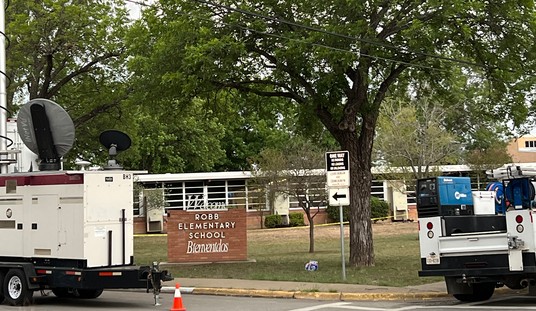Seems like a fair question. Billions of dollars vanished almost overnight into the FTX-Alameda crypto abyss, and the main intersection between the two is Sam Bankman-Fried, colloquially known as SBF.
At literally the same time that the US government spends its time warning the rest of us to diligently report Venmo payments over $600, SBF remains at large with billions of dollars in investor money missing. He’s spending his time trying to explain that away in a bizarre media blitz over the past week. Yesterday, the Wall Street Journal got the latest version of SBF’s excuses, which now includes the claim that he had no idea how money got transferred between FTX and Alameda — even though he owned and/or controlled both:
In an interview with The Wall Street Journal, Mr. Bankman-Fried distanced himself from Alameda, saying he had stepped back from running the firm and had little insight into its workings even though he owned 90% of it.
Some FTX customers made deposits by wiring money to Alameda-controlled bank accounts, with the intention that the money be used to fund their FTX accounts. That was a legacy of the exchange’s early days when FTX didn’t have its own bank account, Mr. Bankman-Fried said. Over time, FTX customers deposited more than $5 billion in those Alameda accounts, he said. Now those funds are gone.
“They were wired to Alameda, and…I can only speculate about what happened after that,” Mr. Bankman-Fried told the Journal.
“Dollars are fungible with each other. And so it’s not like there’s this $1 bill over here that you can trace through from start to finish. What you get is more just omnibus, you know, pots of assets of various forms,” he added.
Genius. In case anyone doesn’t know this, dollars are always fungible — with each other, other currencies, commodities (such as crypto), etc. Dollars and currency in general are designed to be fungible, and in fact fungibility is their raison d’etre. It’s called liquidity, for Pete’s sake. That’s why entities like FTX and Alameda are usually required to maintain strict controls on the use of such fungible assets, especially when acting on behalf of clients. Commingling funds in the manner that SBF all but admits here is a serious financial crime, not to mention what happened to the money after the commingling.
That brings us to CNBC’s question of the day. SBF seems compelled to offer ludicrous statements like this in public nearly every day. So where’s the Department of Justice?
But during Bankman-Fried’s press junket of the last few weeks, the onetime wunderkind has spun a new narrative – one in which he was simply an inexperienced and novice businessman who was out of his depth, didn’t know what he was doing, and crucially, didn’t know what was happening at the businesses he founded.
It is quite the departure from the image he had carefully cultivated since launching his first crypto firm in 2017 – and according to former federal prosecutors, trial attorneys and legal experts speaking to CNBC, it recalls a classic legal defense dubbed the “bad businessman strategy.”
At least $8 billion in customer funds are missing, reportedly used to backstop billions in losses at Alameda Research, the hedge fund he also founded. Both of his companies are now bankrupt with billions of dollars worth of debt on the books. The CEO tapped to take over, John Ray III, said that “in his 40 years of legal and restructuring experience,” he had never seen “such a complete failure of corporate controls and such a complete absence of trustworthy financial information as occurred here.” This is the same Ray who presided over Enron’s liquidation in the 2000s.
In America, it is not a crime to be a lousy or careless CEO with poor judgement. During his recent press tour from a remote location in the Bahamas, Bankman-Fried really leaned into his own ineptitude, largely blaming FTX’s collapse on poor risk management.
Wanna bet? If SBF commingled funds and profited from it, an Urkel-esque “did I do that?” is not going to get him off the hook. The “bad businessman strategy” is not unknown to prosecutors, clearly, and neither is the “crooked trusted employee strategy” that SBF has also deployed the past couple of weeks. SBF has tried passing the buck to his former girlfriend Carolyn Ellison, who ran Alameda for him. However, even if Ellison committed crimes at Alameda, it still doesn’t explain how FTX depositor funds ended up backstopping Alameda when such moves were explicitly restricted by FTX’s terms of service.
ABC legal analyst Dan Abrams scoffs at this as a legal strategy:
“His basic defense, it sounds like, is, ‘I didn’t have the intent. I wasn’t trying to do it.’ That’s not enough in a lot of cases. That’s not going to protect him necessarily from getting indicted. But it is something we hear from CEOs who get tried, and it almost never works.”
Abrams added that Bankman-Fried could be facing a long time in jail.
“We’re talking about, by the way, the possibility of up to life in prison,” he said. “When you’re talking about this much money, in the federal sentencing guidelines, you’re talking about the possibility of enhancement after enhancement after enhancement based on the dollar amounts that could lead to something up to life.”
Earlier this week Coinbase CEO Brian Armstrong said of Bankman-Fried, “It’s “baffling to me why he’s not in custody already.”
That also is a very good question. At the very least, one might think that the DoJ would want to get SBF back to the US to interrogate him about where the missing billions of dollars went. Some of them, albeit a relatively small percentage, went into the Democrats’ midterm campaigns, which may explain why the DoJ seems less than enthusiastic about pursuing SBF at the moment:
The explosive demise of crypto giant FTX, led by billionaire Sam Bankman-Fried, may have an outsized impact on politics — snuffing out the wealth of a budding potential Democratic megadonor.
Bankman-Fried was the second-largest Democratic donor this election cycle by a longshot, according to the most recently available campaign finance data from the Federal Election Commission, second only to philanthropist George Soros.
He donated more than $39.7 million to primarily Democratic causes during the 2022 federal election cycle, including six-figure checks to the Democratic National Committee and the Senate Democrats’ main super PAC, as well as $6 million to the super PAC leading Democrats’ efforts to hold the House.
The only Democratic donor to give more last cycle was philanthropist George Soros, whose $129 million dwarfed Bankman-Fried’s.
After Watergate, we all learned a very useful guiding principle: follow the money, The very fact that the DoJ seems uninterested in doing so speaks volumes about where the SBF scandal originated and likely will go.








Join the conversation as a VIP Member